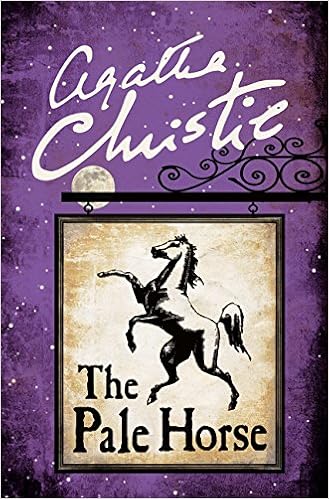
The Pale Horse by Agatha Christie. My copy is a hardback published in 1961 for The Crime Club.
Neither Hercule Poirot, nor Miss Marple feature in this novel and Mrs Ariadne Oliver has only a small part. Detective Inspector Lejeune is in charge of the investigation into the murder of Father Gorman who was killed one night on his way home. A list of names is found on Father Gorman’s body, seemingly unconnected in any way. The title, a reference from the Book of Revelation to a pale horse ridden by Death suggested to me from the beginning that what they had in common was death.
Mark Easterbrook, an historian and friend of Mrs Oliver, is drawn into the mystery when he meets an old friend Dr Corrigan, a police doctor, who shows him the list. Mark recognises two of the named people, both of whom are now dead. His cousin Rhoda lives in Much Deeping where he meets Ginger, a young red-haired woman and a friend of Rhoda. They visit The Pale Horse, an old house which was formerly an inn in the village and is now the home of three weird women, thought by the locals to be witches. The Pale Horse is also the name of a sinister organisation that arranges murders based on black magic. Together, Mark and Ginger set out to unravel the mystery of the Pale Horse, but it is down to Inspector Lejeune to find the killer.
The book is a study of evil. Some of the characters are together discussing witchcraft and the nature of evil. Venables, a man crippled with polio says:
‘I can’t really go along with this modern playing down of evil as something that doesn’t really exist. There is evil. And evil is powerful. Sometimes more powerful than good. It’s there. It has to be recognised – and fought. Otherwise -‘ he spread out his hands.’We go down to darkness.’ (page 70)
It’s a fascinating book conveying a feeling of real menace. As usual with Agatha Christie’s books there are several suspects and various red herrings. However, I began to suspect who the culprit was quite early on in the book and this time I was right. This did not detract at all from my enjoyment and I hadn’t worked out the method until right at the end. I liked the various references to previous crimes that Agatha Christie dropped into the narrative, and also the portrait of Mrs Oliver as an author who liked her own privacy and disliked the embarrassing questions, always the same, that people asked her every time:
What made you first think of taking up writing? How many books have you written? How much money do you make? (page 17)
Reading about The Pale Horse in John Curran’s book Agatha Christie’s Secret Notebooks I discovered that this novel was mentioned during the trial in 1972 when Graham Young was convicted of murder, using the same method as detailed in the book, although he denied having read The Pale Horse. Still, it’s a disturbing thought, one that often occured to me when I used to watch TV programmes such as Wire in the Blood (I can’t watch it any more, it’s far too gory for me).
You were quick off the mark Margaret! I’m looking forward to reading it. Thanks for contributing to the Crime Fiction Alphabet. Can I ask you to also submit it to the next Agatha Christie Blog Carnival please: http://acrccarnival.blogspot.com/
LikeLike
I don’t rember reading this Agatha Christie book. Thanks for the review. I will check it out!
Here is my Crime Fiction Alphabet: P post!
LikeLike